The project of self-propelled anti-aircraft installation T77 (USA)
The development of the project of a promising anti-aircraft self-propelled gun based on the Chaffee tank was launched in accordance with the order of July 22 from 1943. A promising machine was supposed to have weapons, consisting of several large-caliber machine guns in the turret. As the basis for the ZSU, the chassis of an existing light tank was selected. It was decided to create a new project as part of the Light Combat Team line - a family of armored vehicles for various purposes, built on the M24 tank chassis. Due to the maximum unification, it was planned to simplify the construction of serial machines, as well as to facilitate their operation and maintenance. Active work on the Light Combat Team started in the middle of 1943, when it was decided to develop several new projects, including T77.
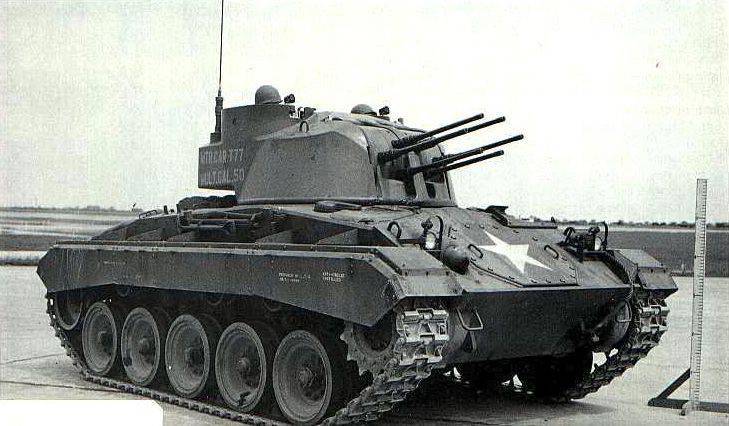
General view of the first prototype T77
The first stage of the new project was the development of a machine gun installation, which should have been mounted in the tower of a promising armored vehicle. The creation of this unit, designated T89, was entrusted to United Shoe Machinery Corporation and air force specialists. As part of the project T89 managed to solve a number of critical problems. The finished system had places for installing four machine guns M2HB of caliber 12,7 mm or similar, was equipped with a remote control and had a number of useful innovations. For example, if the ZSU turret was properly designed, the flashes of shots and the smoke from machine guns did not interfere with the aiming operators to follow the target and continue firing with sufficient effectiveness.
The military department has studied the new project T89 and approved it. In October, having received the appropriate order, the company-developer began manufacturing a machine-gun installation. In December, the finished model was again shown to the military. The design of the developed system did not fully suit the military department specialists. The customer demanded to make a number of changes, first of all, to increase the number of machine guns from four to nine. In addition, some other improvements were needed, primarily related to the strengthening of weapons. Until the early spring of 44, army experts and United Shoe Machinery Corporation were involved in project changes. In the modified version, he received a new designation - T89E1.
After analyzing the updated draft of the machine gun, in April 1944, the army approved the construction of high-grade prototypes of the advanced self-propelled self-propelled gun. In the foreseeable future, it was planned to build two such machines, but before they began assembling, it was supposed to make models of some units. By the beginning of the summer, a full-size ZSU model was assembled on a full-fledged tank chassis, equipped with a mock turret with a machine-gun. After checking the layout and some improvements, the assembly of a full-fledged prototype of the machine-gun installation was launched.
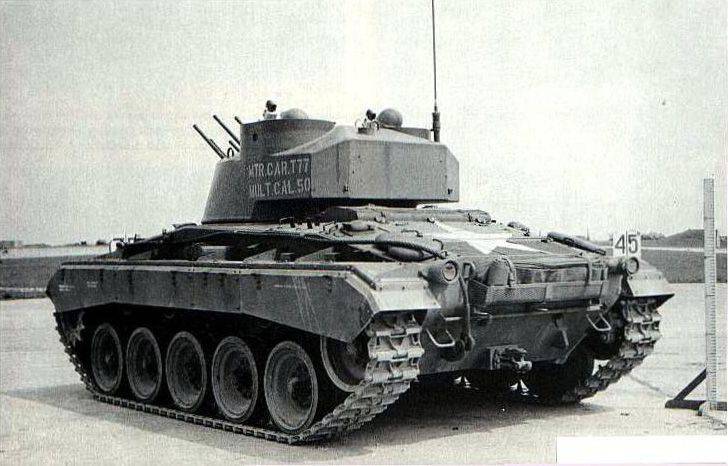
T77, rear view
In October, the 44 was prepared for testing a sample of a machine-gun installation, which soon came to the test. Significant processing and refinement design is no longer required. In November, the military approved the start of construction of a full-fledged combat vehicle with the installation of T89E1. By this time, the project of anti-aircraft self-propelled secured its own designation T77 Multiple Gun Motor Carriage. Also in some sources there is a different designation - Multiple .50 Caliber Gun Motor Carriage, reflecting the basic parameters of weapons.
As a basis for the ZSU T77, the chassis of the lightweight tank M24 Chaffee was taken. Unlike a number of other projects of the Light Combat Team family, the T77 project did not offer to noticeably change the layout of the base chassis. As planned by the authors of the project, in the case of the T77, the tower with the new weapons should be installed on the existing shoulder strap without any modifications. Thus, the overall architecture of the base chassis remained unchanged. In front of the hull there was a transmission compartment and a control compartment, behind them was a fighting compartment with a turret, and engines were installed in the stern.
The hull has not changed. It was supposed to be welded from armor plates with a thickness up to 25 mm, moreover, several cast parts were provided. The shape of the hull and the location of the various units, including the hatches of the crew and the shoulder strap of the tower, remained the same. Applied armor parts provide protection from small arms weapons and artillery shell fragments.

Front and rear views
The power plant, as before, consisted of two eight-cylinder engines Cadillac 44T24 XHUMX horsepower. With the help of cardan shafts, passing under the floor of the fighting compartment, torque was transmitted to the gearbox and other units of the front transmission compartment. The drive wheels, respectively, were located in front of the hull.
Chassis used without any modifications. It consisted of five dual track rollers on each side. Used torsion bar suspension with additional shock absorbers on the two front and two rear pairs of rollers. Also provided for several supporting rollers.
It should be noted, both the prototype T77 self-propelled self-propelled guns were not built from scratch, but were built on the basis of existing light tanks. Thus, in practice, the main chassis aggregates really did not receive any noticeable changes.
On the chase of the hull during the construction of ZSU T77 MGMC it was proposed to install a new tower of the original design. It was made of sheets of thickness 12,7 mm, which allowed to protect the crew and units from small arms. Due to the need to accommodate a large number of different units, the tower received a relatively wide frontal part and a narrower feed niche raised above the hull roof. It was proposed to mount the T89E1 machine gun in the frontal part of the turret, the crew seats were placed in the middle (at the sides).
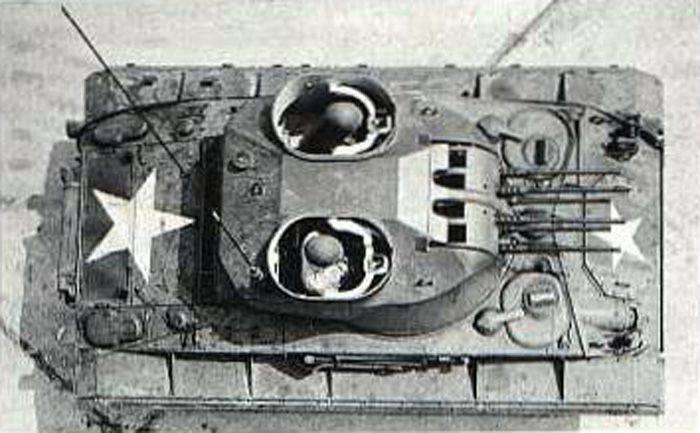
View from above. The open turrets of the commander and the gunner are clearly visible.
The main element of the new turret was the machine-gun installation of the original design. In a special case with a protected frontal part, six places were provided for the installation of large-caliber machine guns. In the central part of the body, four machine guns were mounted in two rows. Two more were located on the sides of them, the height between the upper and lower row. Viewed from the front, the barrels of the machine guns formed a hexagon. In order to reduce the size of the installation central machine guns were mounted with a slight collapse in hand. All machine guns were equipped with remotely controlled trigger mechanisms and the necessary systems of tape ammunition associated with ammunition storage units.
Behind the installation T89E1, in front of the crew, there was a machine gun ammunition system. Due to the relatively high rate of fire and ammunition consumption, the authors of the project needed to use rather large ammunition storage systems. Four central machine guns had ready-to-use ammunition in the amount of 3600 ammunition - 900 each. In the boxes of the side machine guns there were 1100 cartridges. If necessary, the crew could reload the weapon, for which 1200 cartridges were also placed in the hull layouts.
The design of the tower allowed using mechanical or manual drives to direct the weapon in any direction in the horizontal plane. Vertical pickup angles ranged from -10 ° to + 85 °. To increase the sector of vertical guidance in the front sheet of the tower had to provide for cuts of complex configuration. In accordance with the terms of reference, the turret turnaround mechanisms and weapons were supposed to provide guidance speeds of up to 65 ° per second. When using manual actuators, this parameter is significantly reduced.
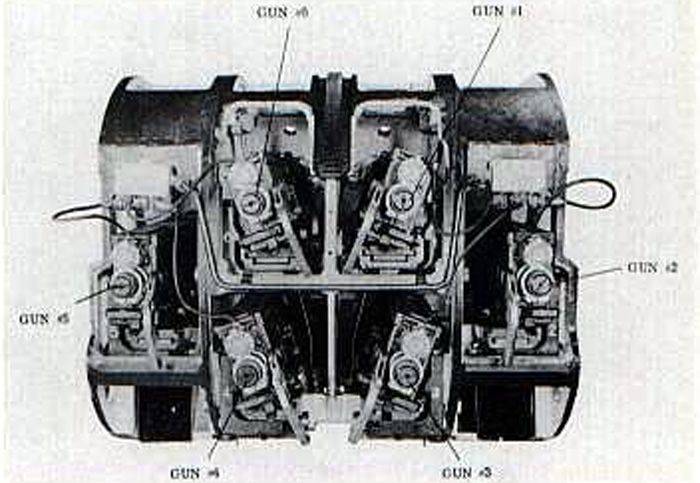
Machine gun installation T89E1, rear view (from inside the turret)
A machine gun mounted in the center of the forehead of the tower. Behind her, at the sides of the middle part of the tower, there were two crew members' workplaces. They were equipped with a set of controls, guidance and shooting. Above the commander’s and gunner’s workplaces, two small open-toed towers mounted on the roof were envisaged. The turrets had swinging bases for the Mk IX and T5E1 sights, which could be raised or lowered in sync with the weaponry. In the stern niche of the tower was provided radio station type SCR 528.
According to calculations, six M2HB machine guns of 12,7 mm caliber could provide high firepower and fire density. With an average rate of fire of the order of 500 shots per minute, the T89E1 setting provided a rate of fire at the level of 3 thousand per minute - up to 50 shots per second. Thus, the self-propelled second salvo, depending on the type of ammunition used, reached 700-750.
The crew of the ZSU T77 MGMC consisted of four people. In the front compartment of the hull control, as before, the workplaces of the driver and his assistant were located. In the tower there were seats for the commander and the gunner. The first two controlled the machine, and the commander and the gunner had to maintain weapons, search for targets and fire. Due to the absence of any automation equipment, the situation was monitored and it was necessary to look for targets only visually. Pointing weapons to some extent facilitated by modern sights.

General view of the second prototype T77E1
In July, 1945, the assembly of the first prototype of the new self-propelled gun was completed. The basis for it was a serial tank “Chaffee”, on which they mounted a new tower of the original design. After the assembly was completed, this vehicle, like many other new armored vehicles, went to the Aberdeen Proving Ground. The use of the finished exhaust chassis and the already tested machine-gun installation made it possible to shorten the test program and quickly determine new project requirements.
In general, the prospective ZSU suit the military, but to continue the work it was necessary to make some innovations in its design. So, the claims were caused by the open hatches of the gunner and the commander in the roof, some elements of the fire control system, etc. Soon all these customer wishes were implemented in the new project with the designation T77E1. The second prototype, ordered back in 1944, was built according to the updated project.
To improve the performance and efficiency of the second prototype received new sights with enhanced performance. To protect the crew and internal units of the tower from precipitation, the height of the towers was slightly increased, and transparent domes were added. The latter consisted of several transparent elements mounted on a metal binding. If necessary, the dome turned back and secured in this position. The size and shape of these units did not interfere with the movement of the rolling sight.
In the autumn of 1945 of the year, a second prototype of the advanced ZSU was made according to the updated project. Soon this machine came to the test and reaffirmed the viability of the basic ideas underlying it. As expected, six large-caliber machine guns with remote control and new sights can easily cope with the attack of existing aerial targets. In addition, with less efficiency it was possible to fight with advanced aviation technology.
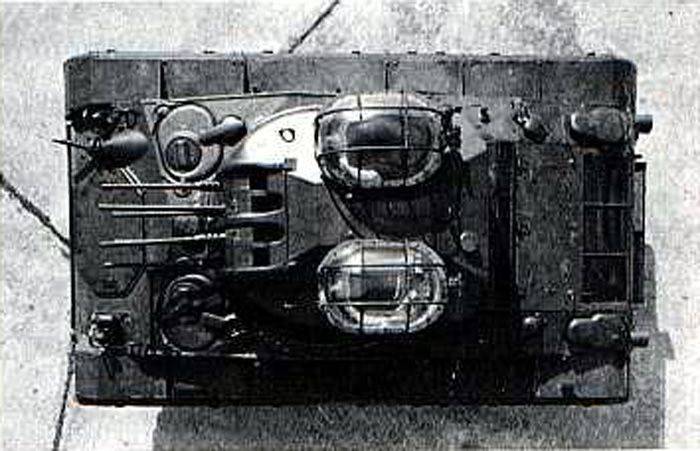
T77E1, top view
However, the T77 / T77E1 projects have not left the stage of testing two prototypes. Despite all the positive features, the prototype machines had some characteristic flaws, which in fact blocked their way to mass production. The basis of these anti-aircraft self-propelled guns was the chassis of the light tank M24 Chaffee, whose prospects in the postwar period were in question. In addition, the end of the Second World War led to a sharp reduction in funding for promising developments, which, among other things, should have affected the creation of new ZSUs. Finally, the increase in the speed of combat aviation constantly reduced the effectiveness of machine-gun anti-aircraft systems.
By the end of 1945, the customer, represented by the military, concluded that there was no need for the further development of the T77 project. Such machines no longer fully met the requirements of the time and could not provide full protection of troops on the march and in positions against modern and prospective combat aircraft. For this reason, all work on the T77 Multiple Gun Motor Carriage has been curtailed.
The further fate of the two prototypes built is unknown. Probably, both cars lost new towers and were refitted in accordance with the current plans of the military and industry. They could become the basis for new prototypes of promising technology or return to the original configuration of a light tank. There are no exact data on this. Nevertheless, it is known that prototypes of the T77 self-propelled self-propelled unit did not survive to our time.
It should be noted that the closure of the project T77 did not lead to a complete stop of work on the subject of self-propelled anti-aircraft installations. In the future, several other projects of similar technology, built on the basis of newer and more advanced chassis, were created. In some new projects, extensive use was made of earlier developments, including the T77 MGMC.
Based on:
http://historyofwar.org/
http://panzeroperations.com/
http://libwar.ru/
http://m24chaffee.com/
Hunnicutt RT Stuart. A History of the American Light Tank, Volume 1. Navato, CA. Presidio Press, 1992
Information